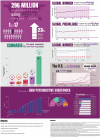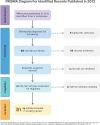On the utilization of the induced pluripotent stem cell (iPSC) model to study substance use disorders: A scoping review protocol
- PMID: 37824561
- PMCID: PMC10569547
- DOI: 10.1371/journal.pone.0292238
On the utilization of the induced pluripotent stem cell (iPSC) model to study substance use disorders: A scoping review protocol
Abstract
Introduction: Induced pluripotent stem cells (iPSCs) are cells derived from somatic cells via reprogramming techniques. The iPSC approach has been increasingly used in neuropsychiatric research in the last decade. Though substance use disorders (SUDs) are a commonly occurring psychiatric disorder, the application of iPSC model in addiction research has been limited. No comprehensive review has been reported. We conducted a scoping review to collate existing evidence on the iPSC technologies applied to SUD research. We aim to identify current knowledge gaps and limitations in order to advance the use of iPSCs in the SUD field.
Methods and analysis: We employed a scoping review using the methodological framework first created by Arksey and O'Malley and further updated by Levac et al. and the Joanna Briggs Institute (JBI). We adopted the Preferred Reporting Items for Systematic reviews and Meta-Analyses extension for Protocols (PRISMA-P) to report items for the protocol. We searched evidence from four electronic databases: PubMed®, Embase®, Web of Science™, and Scopus®. Primary research, systematic reviews, and meta-analyses were included and limited to studies published in English, at the time from 2007 to March 2022. This is an "ongoing" scoping review. Searched studies will be independently screened, selected, and extracted by two reviewers. Disagreement will be solved by the third reviewer and discussion. Extracted data will be analyzed in descriptive and quantitative approaches, then summarized and presented in appropriate formats. Results will be reported following the Preferred Reporting Items for Systematic reviews and Meta-Analyses extension for Scoping Reviews (PRISMA-ScR) guideline and disseminated through a peer-reviewed publication and conference presentations.
Conclusion: To our best knowledge, this is the first comprehensive scoping review of iPSC methods specifically applied to a broad range of addictive drugs/substances that lead to SUDs or misuse behavior.
Registration: This protocol is registered on Zenodo repository (https://zenodo.org/) with doi:10.5281/zenodo.7915252.
Copyright: © 2023 Niemis et al. This is an open access article distributed under the terms of the Creative Commons Attribution License, which permits unrestricted use, distribution, and reproduction in any medium, provided the original author and source are credited.
Conflict of interest statement
The authors have declared that no competing interests exist.
Figures






